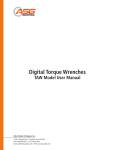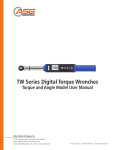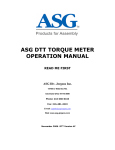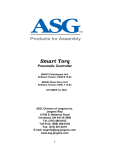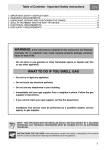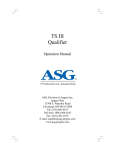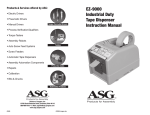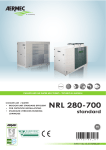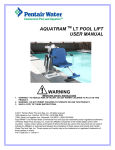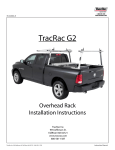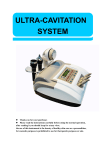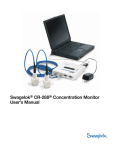Download ASG Digital Torque Wrench User Manual
Transcript
Digital Torque Wrenches TW Model User Manual ASG, Division of Jergens, Inc. 15700 S. Waterloo Road | Cleveland, OH 44110-3898 Phone: (888) 486-6163 | Fax: (216) 481-4519 Email: [email protected] | Web: www.asg-jergens.com Table of Contents Basic Description Recommended Use General Characteristics Care Guidelines Modes of Operation Language Mode Unit Mode Date Mode Track Mode Peak Mode Set Mode Preset Mode Recall Mode Upload Mode Clear Mode COMMS Mode PCFE - ASG Software Communication with PCFE PCFE Interface Glossary PCFE Instructions PCFE Language The PC Front End - Whole Page The PC Front End - Top of Page Set a Preset The PC Front End - End of Page Continuous Upload Upload All Clear Wrench Data Clear Results Unit Conversion Connection Status Torque Wrench Calibration Optional Wireless Technology 2 Basic Description The Digital Torque Wrench is a state-of-the-art hand-held device suitable for both torque auditing & also torque application. These precision tools have both high torque accuracy & also high repeatability. For product portfolio cohesion, this model torque wrench uses the same organic LED display, membrane type keypad, user interface and also PC based data management software as other standard products within this range of electronic torque tools. Training up time is minimal with a key feature being the ease of use. These products are demonstrated to have better than 1% accuracy. They are both simple to set and calibrate and come complete with fully traceable ISO 6789-2003 certification. The Digital Torque Wrench has both visual and audio alarms to signal good or bad torque. Along with this, there is a visual battery life indicator and alarms for preset value approach, fastener overload, range overload and maximum mechanical overload. Recommended Use The Digital Torque Wrench is specifically designed for use in all industrial sectors and applications where high accuracy and repeatability combined with a complete torque data management and control system are standard requirements. General Characteristics Accuracy Right hand side torque = 1% Left hand side = 1% of Actual Reading Resolution 0.01 N.m - 50 N.m 0.1 N.m - 1000 N.m Alarms Preset Value Approach, Range Overload, Mechanical Overload, Low Battery, Memory Full Memory Capacity 2094 Values Battery Life Sleep Mode: 5,000 Hrs Operational Mode: For Standard Model: Up to 120 Hours Optional Wireless Model: Up to 40 hours www.asg-jergens.com | Phone: (888) 486-6163 | Fax: (216) 481-4519 3 Basic Description Care Guidelines • These instruments should be handled with care • Do not subject to torque loads in excess of the model range • Do not use tool to loosen fasteners tightened beyond maximum tool capacity • Using non-linear extensions may affect the torque accuracy • Using torque extensions will increase the torque applied • Do not operate tool unless it has been powered on and the display screen can be read clearly • Do not drop or subject to impact blows • Provide adequate storage to protect from damage • Adhere to safety instructions • As torque is length dependent, therefore torque should be applied to the center of the torque wrench handle Changing the Battery Step 1: Unscrew the metal end cap on the handle of the wrench Step 2: Remove the four AA cell batteries and replace with new Step 3: Screw back the metal end cap Step 4: Turn on the wrench and check to ensure the date and time are both set correctly Step 5: Practical usage time for rechargeable batteries is shorter than for standard batteries Ratchet Head Guidelines • Store in a dry location • Oil frequently to prevent ratchet head seizing • Do not use external forces on ratchet (i.e. hammer) • Do not exceed specified torques • Max Torque for 1/4” Ratchet = 30 Nm • Max Torque for 3/8” Ratchet = 135 Nm • Max Torque for 1/2” Ratchet = 340 Nm 4 Modes of Operation Torque reading starts at 5% of maximum with an accuracy of 1% beginning at 10% of maximum (threshold to maximum span). Press to select the required Menu option and to select. Language Mode - Keypad Function The languages of operation available to the user are: English, Chinese, French, German, Italian, Polish, Portuguese, Russian, Spanish Step 1: Press to scroll to the Language Menu Step 2: Press to enter Language Menu Step 3: Press Step 4: Press to scroll to the language required to confirm operation in this language Unit Mode - Keypad Function: The following units of measurement are available: kgf.cm, kgf.m, cN.m, N.m, ozf.in, lbf.in, lbf.ft Step 1: Press to scroll to the Units Menu Step 2: Press to enter Units Menu Step 3: Press Step 4: Press to scroll to the units required to confirm selected units www.asg-jergens.com | Phone: (888) 486-6163 | Fax: (216) 481-4519 5 Modes of Operation Date - Keypad Function: Step 1: Press to scroll to the Date Menu Step 2: Press to enter Date Menu Step 3: Press Step 4: Press to scroll to set the min/hour to confirm To set the day/month/year, repeat step 3 and step 4 Track Mode: As torque is applied, the driver will actively display the applied torque reading from 5% up to the max span of the device. On removal of the torque load the display will return to zero. Step 1: Press to scroll to Track Mode Step 2: Press to operate in Track Mode Peak Mode: In Peak Mode, on condition that the torque loaded is above 10% of the tool span, then the maximum torque reading will remain displayed when the torque load is removed. The user has the option to store the reading in memory. If storage of the reading is not required, the user may continue to the next measuring task. Step 1: Press to scroll to Peak Mode Step 2: Press to operate in Peak Mode Step 3: Press to store the peak value if required. If storage is not required, then apply new torque. 6 Modes of Operation Set Mode: This mode allows the user to set the limits for torque. The operator can choose to set torque values by % or by tolerances. After, in operation of these presets the OLED display will be green approaching preset tolerances and will change to red if exceeded. Step 1: Press to scroll to Set Mode Step 2: Press to select Set Mode Step 3: Press to scroll to set by % or set by tolerance Step 4: Press to scroll to scroll to required present number (1 to 99) Step 5: Press to confirm preset number selected Step 6: Press to set nominal value and to confirm Step 7: Press to set your low value and to confirm Step 8: Press to set your high value and to confirm Step 9: Once the parameters have been confirmed the operator can find the task within Preset Mode. Use to select Preset Mode from the main menu to find the task. To set a preset as a +/- % deviation of the nominal value, please select “Set Torque” and then select “by %” www.asg-jergens.com | Phone: (888) 486-6163 | Fax: (216) 481-4519 7 Modes of Operation Preset Mode: This mode allows the user to operate using target, minimum and maximum parameters prepared in Set Mode. Depending on the max torque loaded, there are relevant warning signals activated. • Passing Min. Value: the green LED on keypad will flash and the buzzer will sound intermittently. The OLED display will change to orange • Passing Nom. Value: the green LED on keypad will switch on and the buzzer will sound continuously. The OLED display will be green • Passing Max. Value: The red LED will flash continuously and the buzzer will sound continuously and the OLED will change to Red. Step 1: Press to scroll to Preset Mode Step 2: Press to enter Preset Mode Step 3: Press to select your preferred preset number (1 to 99) Step 4: Press to operate within this preset parameter Step 5: Press to store the applied torque (torque and angle) if required Recall Mode: This mode allows the user to view the stored torque and angle data. Only locations containing data will be displayed. Note that as data is stored the locations are populated sequentially from 01 to 2094. 8 Step 1: Press to scroll to Recall Mode Step 2: Press to enter and view memory locations, results and functions Step 3: Press to scroll through locations that contain data Modes of Operation Upload Mode: This mode allows the user to upload stored torque data. In Upload Mode, the driver must be connected to a PC running the PC FRONT-END Software (PCFE) via the USB Port on the driver and PC. Step 1: Press to scroll to Upload Mode Step 2: Press to enter Upload Mode Step 3: Press to select “From” and location to upload to select the first sorted data Step 4: Press to confirm “From” location Step 5: Press uploaded to select “To” location and Step 6: Press to confirm. You are asked if you are sure, press for end location to be to confirm COMMS Mode: This mode allows the user to select the method for communication. The standard model allows communication by standard USB Cable to the included software. For communication by ASCII or BINARY the wrench will need physical modifications in advance. Step 1: Press to scroll to COMMS Mode Step 2: Press to enter COMMS Mode Step 3: Press to select the method of communication and to confirm Note: For standard communication to the included software program, select ‘PCFE’ www.asg-jergens.com | Phone: (888) 486-6163 | Fax: (216) 481-4519 9 Modes of Operation Clear Mode: This mode allows the user to clear the stored torque data from an individual or range of locations. Note: Before clearing the selected range and as a safety precaution, the user will be asked are they sure they wish to clear selected data. This can be done by pressing the confirm button. 10 Step 1: Press to scroll to Clear Mode Step 2: Press to enter Clear Mode Step 3: Press to select “From” range to be cleared and press Step 4: Press to confirm “To” range to be cleared Step 5: Press to confirm and you will be asked if you are sure Step 6: Press wrench memory to confirm and that the range of the data is cleared from the PCFE - ASG Software Communication to PCFE • PCFE: ‘PC Front End’ is the standard software which is included with the tool Installation Select Setup.exe from USB Storage Device The user can choose from options within the window below interface • Demo PCFE: this will allow the user to test the software without installing • Install PCFE.exe: to install the software to the PC • Instructions: user manual Install the PCFE.exe • During the steps for installation, there is a search to ensure the .net framework is present and installs it from the web if required • USB drivers are automatically installed but should there be the need, they can also be manually installed – and can be found at C:/program files/PCFE/Front-end/ USB drivers • After installation the PCFE Icon will appear on the desktop. No password is required; just click OK when prompted for a password • The screen can be re-sized and the new setting will remain on next opening Communication to PCFE Connect a USB cable from PC to the torque wrench. The HID driver will self-install and prompt you when the process is complete. www.asg-jergens.com | Phone: (888) 486-6163 | Fax: (216) 481-4519 11 PCFE - ASG Software Select Port There will be two options: • Com Port 1: this will allow you to connect the older type tools using the RS232 cable • The serial number(s) of the wrench connected Note: After you configure or view data on the tool and disconnect from PCFE, select Com Port 1 afterwards to close the virtual port. 12 PCFE - ASG Software PCFE Interface Glossary • Select Port: Select communication port you wish to use to communicate with the wrench • Current Mode: Select mode you wish the tool display on start up. Selection will take effect after data is stored using ‘store to wrench button’ • Current Units: Select the torque units you wish the tool to operate with. Selection will take effect after data is stored using ‘store to wrench button’ • Current Language: Select the language you wish the tool to operate in. Selection will take effect after data is stored using ‘store to wrench button’ • Tool Span: For these torque tools, the quoted accuracy is 1% of actual reading from 10% to 100% of the actual reading. ‘Tool Span’ will indicate the 100% limit for this specific driver • Period of Calibration: Set number of days to next calibration or it can be set by number of measurements • Calibrated On: Date of last calibration • Activate Calibration: Activates the calibration option in the tool on-board menu. You must begin calibration before the wrench powers down • Reset the Wrench: Allows tool reset. All calibration data/settings stored in the Driver will be cleared and default calibration values for a calibration span will be programmed. This is not an alternative method for calibration • Power Off Wrench: Allows soft power down of the driver • Store to Wrench: Store all current PC front settings to driver. Driver will automatically power down after store • Load from File: Loads a previously created file containing preset data into the PCFE front preset window (top left) • Save to File: Saves PCFE displayed preset data to file • Clear all Presets: Clears presets from the PCFE presets window • To set a Preset: Click on any preset location number in the PCFE presets window. Set the required nominal, min, max tolerance and units. Store settings to the driver • Continuous Upload: Allows real time communication of measurements to the PCFE. Driver must be connected to the PC www.asg-jergens.com | Phone: (888) 486-6163 | Fax: (216) 481-4519 13 PCFE - ASG Software PCFE Interface Glossary (Continued) • Upload All: Uploads & displays all stored driver measurement data in the PCFE data window • Clear: Clears the driver measurement data displayed on the PC • Clear Wrench Data: Clears the driver measurement data displayed on the PCFE and in the driver • Unit Conversion: Allows user to change the units of the displayed measurement data on the PCFE • Sort by Preset: Sort the displayed measurement data and group according to ascending preset numbers • Save as an Excel File: Save the current displayed measurement data as an excel file. The PCFE measurement data window displays stored wrench measurements showing driver memory location, date and time, torque value PCFE Instructions No password is required when starting the PCFE software, click OK when the password entry screen appears. 14 PCFE - ASG Software PCFE Instructions Language The PCFE languages available include: English, French, German, Italian, Polish, Portuguese, Spanish, Russian and Chinese PCFE Interface The top section of the PCFE displays wrench configuration data The bottom section allows the user to manage the stored wrench data The right upper half of the PCFE window displays data such as tool serial number, make, model, torque span and units of measurement. The date of calibration and the period of calibration are also shown in this section. www.asg-jergens.com | Phone: (888) 486-6163 | Fax: (216) 481-4519 15 PCFE - ASG Software PCFE Instructions (Continued) Serial Number Current Settings: mode, language, units, power off time Model Make Wrench Span and Units: change these and tool must be recalibrated Activate Calibration Date of calibration, calibration co-efficients, duration of calibration Store to Wrench: stores any changes the user makes to the wrench current settings The left upper section displays the presets stored in the tool - the user can choose to use the PCFE to set the presets or it can be done manually on the tool. The bottom half of the PCFE window displays any stored measurements on the tool. It displays location, number of data on tool, date and time of reading, torque readings, preset data, units of measurement and the mode that was used to take the torque measurement. 16 PCFE - ASG Software PCFE Instructions (Continued) Set a Preset using the PCFE Step 1: Ensure the wrench is connected to the PCFE software selected using ‘Select Port’ Step 2: Select the preset number or location from 1 to 99 you wish to set Step 3: When the pop up window appears fill in required fields and press OK Step 4: Select ‘Store to Wrench’. Data is written to the tool Step 5: Select Preset option on the tool and select the required preset www.asg-jergens.com | Phone: (888) 486-6163 | Fax: (216) 481-4519 17 PCFE - ASG Software PCFE Instructions (Continued) The lower section of the PCFE allows the user to view stored results from the wrench. These results can then be saved as an excel file for further analysis and to offer the user complete traceability of their torque measurements. Shows Com Port Selected Shows that the Wrench is Connected Current Software Version Indication Bar Each row will display the following: time and date of torque operation, torque value and units. If it’s a preset result then the minimum and maximum tolerances are displayed along with the nominal setting The “Mode” column will display the function that was used for the torque operation. In the example you can see peak and preset Continuous Upload: When the wrench is connected to the PCFE and this is selected then the user can take reading’s and by pressing confirm on the wrench the result will be automatically updated to the PCFE Upload All: Once the tool is connected to the PCFE, selecting this option will upload all the wrench stored measurements to the PCFE Clear Wrench Data: Selecting this option will clear the stored results from the tool memory Clear Results: Selecting this button on the PCFE will clear the displayed PCFE results Unit Conversion: Selecting this button allows the user to convert the displayed PCFE readings between N.m, cN.m, lbf.ft, lbf.in, kgf.m and kgf.cm 18 Torque Wrench Calibration Calibration is achieved using 8 measuring points, namely 10%, 20%, 60% and 100% of maximum span in both clockwise and counter-clockwise directions. In Calibration Mode the tool will automatically display these measuring point values initially for the right hand and then for the left hand. All products should be 1% accurate. • De-stressing wrench implies that the wrench is torqued to its maximum span • Ensure date & time on tool are correct before calibrating • Calibration Mode is only accessible through the master and distributor versions of the PCFE software • Calibration Mode will not appear on the tool unless activated using the PCFE software • A certified system with accuracy of 0.25% should ideally be used to calibrate Step 1: Connect wrench to PCFE software and click the ‘Activate Calibration’ button Step 2: Press on the wrench to scroll to Calibrate Mode Step 3: Place tool onto calibration unit. The reaction post should contact the center of the handle grip. The wrench would be kept perpendicular to the static torque tester. De-stress to the CW (clockwise) direction Step 4: Press to activate Calibrate Mode. The wrench OLED will now display a static reading of 10% of the maximum span of the wrench Step 5: Apply torque to the tool until the reading on the calibration rig is equal to the reading on the tool (10% of maximum span) Step 6: Press to confirm that the first point of calibration is now set Step 7: Next, measurement point no. 2 (20% of maximum span) will appear on the Tool OLED display. Repeat step 5 and step 6 Step 8: Next, measurement point No. 3 (60% of Maximum Span) will appear on the Tool OLED display. Repeat step 5 and step 6 Step 9: Now measurement point no. 4 (100% of Maximum Span) will appear on the Wrench OLED display. Repeat step 5 and step 6 Step 10: Repeat Step 1 to Step 9 for the left hand calibration Step 11: Once calibration is complete select track mode on wrench. On the left hand side check wrench accuracy at 20%, 60% and 100% according IS06789-2003. Step 12: Now de-stress on right hand side and repeat step 11. www.asg-jergens.com | Phone: (888) 486-6163 | Fax: (216) 481-4519 19 Optional Wireless Technology • Easy to set-up and use • Numerous safety features prevent data loss • To use the Digital Torque Wrench as a wireless torque wrench it should be used together with the wireless master receiver 20




















